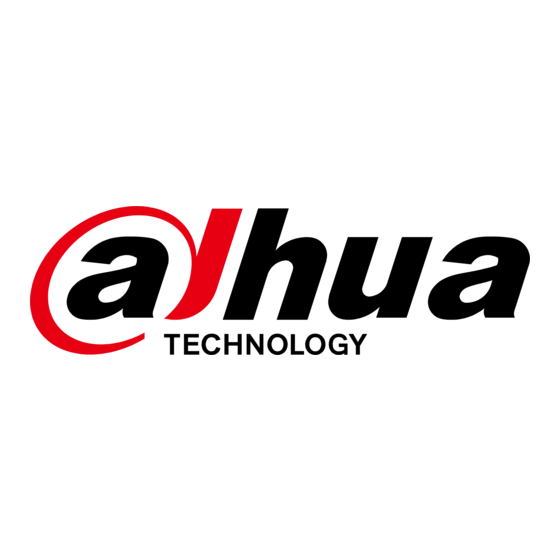
Table of Contents
Advertisement
Quick Links
Advertisement
Table of Contents

Summarization of Contents
Foreword
General Information
Introduces the manual's scope and purpose for the villa door station.
Safety Instructions and Signal Words
Explains signal words like DANGER, WARNING, and NOTE used in the manual.
Revision History
Details the product version, revision content, and release date.
Privacy Protection Notice
User obligations for personal data protection and compliance with privacy laws.
About This Manual
Provides general disclaimers and notes about the manual's content and use.
Important Safeguards and Warnings
Installation Safeguards
Guidelines for safe and correct device installation, including power requirements.
Operation Safeguards
Precautions for safe operation, particularly concerning battery packs.
1 Structure
1.1 Villa Door Station (Multiple Buttons)
Details front and rear panel components of the multi-button villa door station.
1.2 Villa Door Station (Single Button)
Details front and rear panel components for various single-button models.
1.3 Button Model
Details the front and rear panel of the button model.
2 Initializing the VTO
2.1 Web Initialization
Steps to initialize the VTO via its web interface.
2.2 DMSS App Initialization
Steps to initialize the VTO using the DMSS mobile application.
3 Login and Password Reset
3.1 Logging In
Procedure for logging into the VTO web interface.
3.2 Resetting Password
Steps to reset the VTO password if forgotten.
4 Home Page Navigation
Local Device Configuration Access
Accesses basic and advanced device configuration settings.
Device Setting Management
Manages VTO, VTH, VTS, and IPC devices.
Person Management Access
Manages user, card, and fingerprint information.
Network Settings Access
Configures network parameters for device connectivity.
System Settings Access
Manages system functions like alarm, video, and time.
Maintenance Center Access
Handles device maintenance, updates, and logs.
5 Setup Wizard
5.1 Setting as SIP Server
Guides through setting the VTO as a SIP server.
5.2 Not Setting as SIP Server
Guides through configuring VTOs not acting as SIP servers.
6 Local Device Configuration
6.1 Basic Settings
Configures fundamental device parameters for Villa Door Station.
6.2 Access Control
Manages access control features and configurations.
6.3 Light Control
Configures illuminator and device light modes.
6.4 Card Settings
Configures IC card usage and encryption.
6.5 Wiegand Settings
Supports and configures Wiegand devices.
6.6 Layout Configuration
Configures device layout for buttons and modules.
6.7 Adding IPC
Adds IPC devices for video monitoring.
7 Device Setting
7.1 VTO Management
Manages VTO devices within the SIP server.
7.2 VTH Management
Manages VTH devices and their room numbers.
7.3 VTS Management
Manages VTS as a management center and for network calls.
8 Person Management
Person Management Details
Manages user, card, and fingerprint data.
9 Network Settings
9.1 TCP/IP Configuration
Configures TCP/IP information for network connectivity.
9.2 Port Configuration
Configures network ports for device access.
9.3 SIP Server Configuration
Configures the VTO or other servers as a SIP server.
9.4 Second Confirmation Station Cascading
Configures cascading for second confirmation stations.
9.5 Cloud Service
Enables cloud service for adding VTO via QR code.
9.6 UPnP Configuration
Configures UPnP to allow WAN devices to log in.
9.7 Wi-Fi Settings
Configures Wi-Fi settings for network connection.
9.8 Basic Services Configuration
Configures security-related functions.
9.9 Auto Registration
Configures automatic VTO registration on a server.
10 System Settings
10.1 Alarm Configuration
Configures alarm functions and sounds.
10.2 Video Settings
Configures video format, quality, and compression.
10.3 Audio Settings
Configures audio settings like volume and prompts.
10.4 Time and Time Zone
Configures time zone, DST, and system time.
10.5 ONVIF User Management
Adds accounts for ONVIF device monitoring.
11 Log Management
11.1 One-Click Diagnosis
Performs automatic diagnosis of device configuration and status.
11.2 System Information
Displays software, hardware, and security baseline versions.
11.3 Data Capacity
Shows storage capacity for users, cards, and images.
11.4 Maintenance Management
Manages configuration export/import and auto-maintenance.
11.5 Update Procedures
Checks for and applies firmware updates.
11.6 Advanced Maintenance
Performs export and packet capture operations.
12 Security Management
12.1 Security Status
Displays the security status of the device.
12.2 System Service Management
Manages system services and device certificates.
12.3 Attack Defense
Configures firewall, account lockout, and anti-DoS attack measures.
12.4 CA Certificate Management
Manages device and trusted CA certificates.
12.5 Video Encryption
Configures private protocol and RTSP over TLS for video security.
12.6 Security Warning
Enables event monitoring for security alerts.
13 Button Model Configuration
13.1 Cable Connection
Details cable connection for the button model.
13.2 VTH Configuration for Button
Configures VTH to receive alarm signals from the button model.
Appendix 1 Security Recommendations
Account Management Recommendations
Provides recommendations for secure password and account setup.
Service Configuration Recommendations
Recommends enabling HTTPS and other secure service settings.
Network Configuration Recommendations
Recommends allow list, MAC binding, and secure network environment.
Security Auditing Recommendations
Recommends checking users, logs, and configuring network logs.
Software Security Recommendations
Recommends timely firmware and client software updates.
Physical Protection Recommendations
Recommends physical security measures for devices.












Need help?
Do you have a question about the E Series and is the answer not in the manual?
Questions and answers